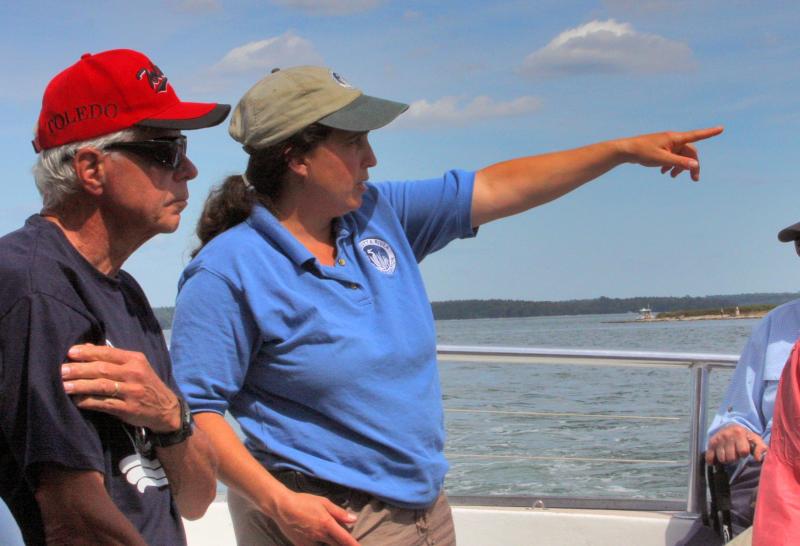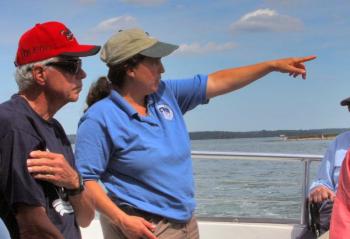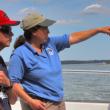Learn about the secret ingredient of the Damariscotta River's aquaculture industry at Schooner Cove
 Sarah Gladu, director of Education and Environmental Monitoring at the Damariscotta River Association, will discuss the past and present of oysters in the Damariscotta River at Schooner Cove on Sept. 7. Sarah and the Damariscotta River Association have a long history with Schooner Cove. Sarah is pictured here pointing out a feature of interest during a boat tour with Schooner residents. Courtesy photo
Sarah Gladu, director of Education and Environmental Monitoring at the Damariscotta River Association, will discuss the past and present of oysters in the Damariscotta River at Schooner Cove on Sept. 7. Sarah and the Damariscotta River Association have a long history with Schooner Cove. Sarah is pictured here pointing out a feature of interest during a boat tour with Schooner residents. Courtesy photo
 Sarah Gladu, director of Education and Environmental Monitoring at the Damariscotta River Association, will discuss the past and present of oysters in the Damariscotta River at Schooner Cove on Sept. 7. Sarah and the Damariscotta River Association have a long history with Schooner Cove. Sarah is pictured here pointing out a feature of interest during a boat tour with Schooner residents. Courtesy photo
Sarah Gladu, director of Education and Environmental Monitoring at the Damariscotta River Association, will discuss the past and present of oysters in the Damariscotta River at Schooner Cove on Sept. 7. Sarah and the Damariscotta River Association have a long history with Schooner Cove. Sarah is pictured here pointing out a feature of interest during a boat tour with Schooner residents. Courtesy photo
The popularity of Damariscotta River oysters goes back at least 2,000 years, when Native Americans began building some of the world’s largest oyster shell middens on the banks of the river.
Today, Damariscotta River oysters have a world-wide reputation in large part due to the cold, briny, nutrient-rich waters of the estuary. But as oyster fisheries come under increasing environmental strain, one of the local industry’s strongest assets might actually be the scientific foundation built by University of Maine Darling Marine Center Scientist Herb Hidu and his students decades ago.
Sarah Gladu, director of Education and Environmental Monitoring at the Damariscotta River Association, will discuss the past and present of oysters in the Damariscotta at Schooner Cove on the Miles Campus in Damariscotta on Sept. 7 at 1:30 p.m.
Gladu will talk about the biology of oysters and how and where they grow in the world and the increasing importance of aquaculture as a means of feeding the world’s ever-expanding population. She will focus on the Damariscotta River’s own unique oyster aquaculture industry.
Local aquaculture got its start largely with the students of Professor Hidu. While oysters have a long history in the Damariscotta River, by the 19th century they had disappeared either because of human activity, such as shipbuilding, or environmental changes, or possibly both. Hidu believed that the river would make an ideal location for an aquaculture industry.
Over several decades, Hidu and his former students developed the technology and the know-how that made the Damariscotta River oyster aquaculture industry so successful. Today, the river grows the vast majority of Maine’s oysters.
Despite that success, however, the Damariscotta oyster aquaculture industry, like other oyster fisheries, faces a range of environmental threats, including warming temperatures that increase the risk of disease and more acidic oceans, caused by rising levels of carbon dioxide in the atmosphere.
As the industry confronts these new threats, the scientifically trained entrepreneurs who developed the aquaculture system in the Damariscotta River are one of its greatest assets, said Gladu.
They not only understand the science of the oyster’s biology and the river’s ecology, but they also understand the business side of the industry.
“They all came with an education about marine science and they were able to bring that to their business plan,” said Gladu.
For more information or to RSVP, please call Karen Westhaver at 563-4001. This talk is free and open to the public, but space is limited, so please RSVP.
Event Date
Address
United States






















